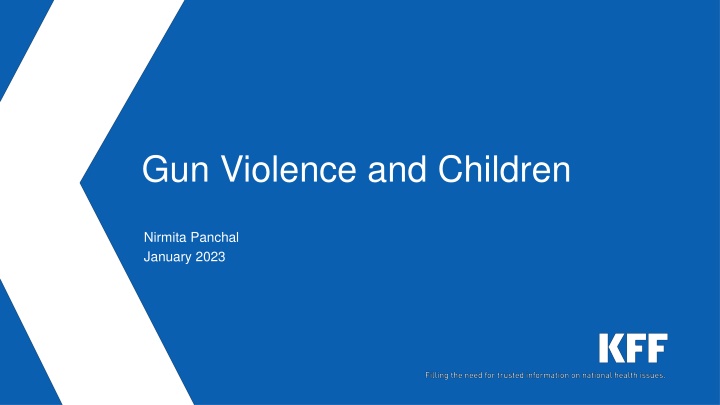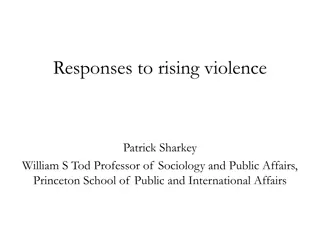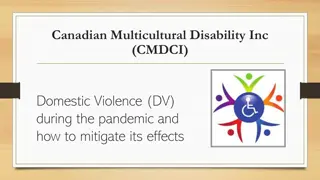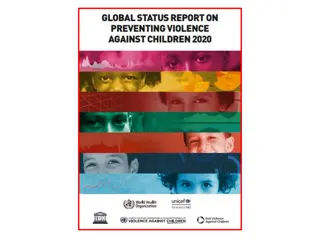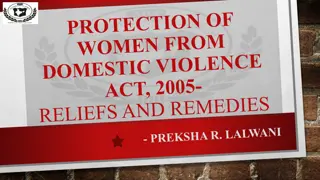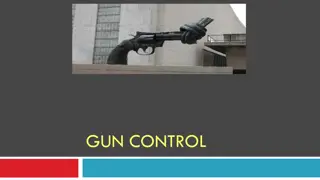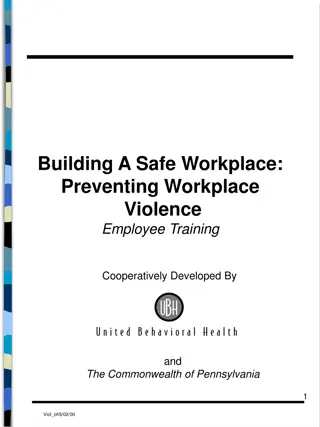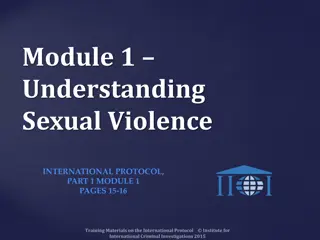Gun Violence and Children: Alarming Trends in the U.S.
Firearms have emerged as the leading cause of death among youth in the U.S., surpassing motor vehicle accidents. Data highlights the concerning rise in firearm-related deaths and the disproportionately high mortality rate among American children compared to peer countries. Suicide deaths by firearm constitute a significant portion of all suicides among children. Various factors contributing to the increase in firearm-related deaths are discussed, including the surge in firearm sales during the pandemic and disparities in data availability and analysis based on demographics.
Download Presentation

Please find below an Image/Link to download the presentation.
The content on the website is provided AS IS for your information and personal use only. It may not be sold, licensed, or shared on other websites without obtaining consent from the author.If you encounter any issues during the download, it is possible that the publisher has removed the file from their server.
You are allowed to download the files provided on this website for personal or commercial use, subject to the condition that they are used lawfully. All files are the property of their respective owners.
The content on the website is provided AS IS for your information and personal use only. It may not be sold, licensed, or shared on other websites without obtaining consent from the author.
E N D
Presentation Transcript
Gun Violence and Children Nirmita Panchal January 2023
Figure 2 Firearms are now the leading cause of death among youth in the U.S. In 2021, seven children per day died by firearm in the U.S. More children in the U.S. died by firearm than by motor vehicle accidents Firearms are the leading cause of death for youth in the U.S. but rank no higher than fifth in other industrialized nations NOTE: For more information, please see https://www.kff.org/other/issue-brief/the-impact-of-gun-violence-on-children-and-adolescents/
Figure 3 The U.S. has by far the highest youth firearm mortality rate among peer countries Firearm mortality rates per 100,000 for children ages 1-19 years, U.S. and peer countries, 2020 U.S. 5.6 Canada 0.8 France 0.5 Switzerland 0.4 Austria 0.4 Belgium 0.3 Comparable country average 0.3 Sweden 0.3 Australia 0.3 Germany 0.1 Netherlands 0.1 U.K. 0.1 Japan 0.1 NOTE: U.S. data are from 2020, all other countries are nearest year, 2019. The comparable country average does not include the U.S. Rates rounded to one decimal place. SOURCE: KFF analysis of CDC Wonder and Institute for Health Metrics and Evaluation (IHME) Global Burden of Disease data
Figure 4 Firearm-related death rates have increased over time among youth 5.0 4.0 3.6 3.0 2.0 1.8 1.0 0.0 2011 2012 2013 2014 2015 2016 2017 2018 2019 2020 2021 NOTE: Rates from 2021 reflect provisional data. Rates are per 100,000 children and adolescents ages 17 and below. Causes of death attributable to firearm mortality include ICD-10 Codes W32-W34, X72-X74, X93-X95, Y22-Y24, and Y35.0. SOURCE: KFF analysis of CDC Wonder, 2011-2020, and CDC Wonder Provisional Mortality Statistics, 2021, Online Databases
Figure 5 By 2021, suicide deaths by firearm accounted for nearly half of all suicides among children and adolescents Number of Deaths Due to Suicide, by Firearm or Other Means, Among Children & Adolescents 2011-2021 1200 1000 800 600 Suicide by Other Means Suicide by Firearm 400 200 0 2011 2012 2013 2014 2015 2016 2017 2018 2019 2020 2021 NOTE: Data from 2021 is provisional. Suicide deaths shown are among children ages 17 and under. Suicide deaths by the discharge of a firearm were identified using codes X72-X74. Suicide deaths by other/unspecified means were identified using ICD-10 codes U03, X60-X71, X75-X84, and Y87.0. It is possible that some suicides may be classified under other categories. SOURCE: KFF analysis of CDC Wonder, 2011-2020, and CDC Wonder Provisional Mortality Statistics, 2021, Online Databases
Figure 6 Other factors to consider as firearm-related deaths rise Firearm sales increased during the pandemic Long-term data limitations Lack of data for non-fatal firearm-related injuries Looking at data across demographics Differences by race and ethnicity have increased NOTE: For more information, please see https://www.kff.org/other/issue-brief/the-impact-of-gun-violence-on-children-and-adolescents/
Figure 7 Firearm death rates sharply increased among Black and Hispanic youth during the pandemic Firearm-Related Death Rates for Children and Adolescents by Race/Ethnicity, 2018-2021 14 12 10 8 6 4 2 0 White Black Hispanic 2019 Asian AIAN 2018 2020 2021 NOTE: Rates from 2021 reflect provisional data. Rates are per 100,000 children and adolescents ages 17 and below. Causes of death attributable to firearm mortality include ICD-10 Codes W32-W34, X72-X74, X93-X95, Y22-Y24, and Y35.0. AIAN refers to American Indian and Alaska Native people. AIAN data for 2018 was unavailable. Persons of Hispanic origin may be of any race but are categorized as Hispanic for this analysis; other groups are non-Hispanic. Persons of more than one race are not included in the data. SOURCE: KFF analysis of CDC Wonder Online Database - Provisional Mortality Statistics, 2018-2021
Figure 8 Considerations in the rise of firearm deaths among Black and Hispanic youth Gun assault deaths from 2019 to 2021 80% increase among Black youth 46% increase among Hispanic youth Suicides by firearm are highest among White youth, but sharply rose among Black & Hispanic youth from 2019 to 2021 77% increase among Black youth 48% increase among Hispanic youth Children of color are more often exposed to gun violence NOTE: For more information, please see https://www.kff.org/other/issue-brief/the-impact-of-gun-violence-on-children-and-adolescents/
Figure 9 Male youth are over four times more likely than their female peers to die by firearm Firearm-Related Death Rates for Children and Adolescents by Sex, 2018-2021 7 5.8 6 5 4 3 2 1.3 1 0 Female Male 2018 2019 2020 2021 NOTE: Rates are per 100,000 children and adolescents ages 17 and below. Causes of death attributable to firearm mortality include ICD-10 Codes W32-W34, X72-X74, X93-X95, Y22-Y24, and Y35.0. Rates from 2021 reflect provisional data. SOURCE: KFF analysis of CDC Wonder Online Database - Provisional Mortality Statistics, 2018-2021
Figure 10 Gun violence can adversely affect the mental health and well-being of children Exposure can lead to PTSD and anxiety, among other mental health concerns Survivors have an increased risk of substance use disorders Challenges with school performance Access to a firearm is a risk factor for suicide NOTE: For more information, please see https://www.kff.org/other/issue-brief/the-impact-of-gun-violence-on-children-and-adolescents/
Figure 11 Mass shootings can negatively impact children s mental health and well-being Account for a small portion of firearm deaths but have far reaching mental health consequences Youth antidepressant use and suicide risk is elevated in communities with exposure to school shootings Knowledge of mass shootings may be linked to increased fear and anxiety Negative psychological impacts from active shooter drills NOTE: For more information, please see https://www.kff.org/other/issue-brief/the-impact-of-gun-violence-on-children-and-adolescents/
Figure 12 Variation in state-level suicide rates for all ages is largely driven by rates of suicide by firearm Suicide Death Rate per 100,000 in 2020, by Type 30 Suicide by other means, age-adjusted rate Suicide by firearms, age-adjusted rate 20 10 0 AK OH OR PA VA GA KY KS OK AZ VT LA AL SC AR SD MA MD MN MS WA ME WV NM MT WY MO CO NJ RI CT HI NC MI WI IN NH TN ND UT ID NY CA DE FL TX NE IA NV IL NOTE: Suicide deaths were identified using ICD-10 113 Cause List in CDC WONDER 2020 data. Suicide deaths by the discharge of a firearm were identified using codes X72-X74. Suicide deaths by other/unspecified means were identified using ICD-10 codes U03, X60-X71, X75-X84, and Y87.0. SOURCE: KFF Analysis of CDC WONDER Underlying Cause of Death data, 2020
Figure 13 Looking Ahead Recent federal law addressing gun reform also aims to expand mental health resources for youth Utilization of these funds? Suicide prevention efforts What are we seeing at the state level with the rollout of 988? Promoting Black youth mental health
Figure 14 Have questions or want more info? Nirmita Panchal, MPH nirmitap@kff.org KFF Mental Health Resources https://www.kff.org/tag/mental-health/ https://www.kff.org/state-category/mental-health/
